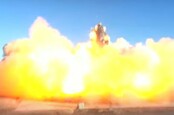This article is more than 1 year old
Faster optic fibers and superior laser sensors set to descend from space
Boffins to get express delivery as SpaceX Dragon capsule returning from ISS will be first science payload to splash down near Florida
SpaceX will on Monday retrieve the Dragon capsule it sent to the international space station on December 8th, 2020, an event NASA says will bring “significantly more science back to Earth than possible in previous Dragon capsules and is the first space station cargo capsule to splash down off the coast of Florida.”
The Register suggests paying particular attention to one of the returning payloads: optic fibres made in space.
The fibres are made using a mix of zirconium, barium, lanthanum, sodium, and aluminium – a cocktail known as ZBLAN.
ZBLAN matters because, as explained to The Register by Jillian Moffatt, a postdoctoral researcher at the University of Adelaide’s Institute of Photonics and Advanced Sensing, the compound delivers superior performance to other optic fibre materials.
“It’s a relatively complex glass with the advantage that it has very high transmission properties over a very long range of wavelengths—from the ultraviolet into the mid-infrared,” Moffatt said. “When thinking about fibre communications, ZBLAN has in theory a smaller loss per metre than normal silica fibres normally used for telecommunications, and a broader range of wavelengths that can pass through—meaning ZBLAN fibres can transmit higher bandwidths of information over a longer distance without needing the signal to be repeated.”
Which could make for fabulous undersea cables.

SpaceX Starship blows up on landing, Elon Musk says it's the data that matters and that landed just fine
READ MOREBut wait, there’s more. “When thinking about research, ZBLAN fibres are exciting due to their transmission properties in the mid-infrared,” Moffatt says. “Silica fibres absorb in this region, so ZBLAN opens up a wider wavelength space to develop mid-infrared lasers, allowing new research development.”
“In particular, the ZBLAN mid-infrared region has a number of strong absorption lines for carbon dioxide and methane among other important atmospheric molecules, and so ZBLAN fibre lasers are being developed for environmental monitoring systems.”
What’s this got to do with the ISS?
“The main problem with ZBLAN fibres is that their excellent properties are lowered by crystallisation within the fibre glass, which occurs when the fibre is cooling,” Moffatt says, adding: “The way the fibre cools in microgravity is different due to differences in convection properties, and so the crystallisation problems with ZBLAN fibre do not occur in space.”
Which is why the ISS is home to a ZBLAN-manufacturing rig, in the hope that large-scale production could become an orbital industry.
“At the moment, ZBLAN fibre in space is mainly for research and laser development, but in the future, it could provide the material for next-generation telecommunications,” Moffatt told The Register.
Another science payload about to land is a group of live mice, so we can study the function of arteries, veins, and lymphatic structures in the eye and changes in the retina before and after spaceflight. This matters because plenty of returning astronauts report dodgy vision. Other returning experiments are hoped to offer insights into regenerative medicine, the performance of the heart in space, and how to control bacteria during long spaceflights.
NASA says the Dragon not only makes it possible to bring more stuff down from the ISS, but the planned retrieval mission will also deliver material faster than previous efforts so that scientists can get a look at the effects of microgravity before terrestrial gravity crushes their hopes, dreams, and data. ®
